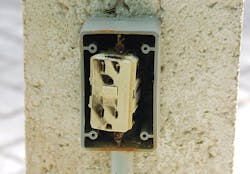How well do you know the Code? Think you can spot violations the original installer either ignored or couldn’t identify? Here’s your chance to moonlight as an electrical inspector and second-guess someone else’s work from the safety of your living room or office. Can you identify the specific Code violation(s) in this photo? Note: Submitted comments must include specific references from the 2014 NEC.
Hint: Just a Wee Bit Short
Tell Them What They Have Won...
Using the 2014 NEC, correctly identify the Code violation(s) in this month’s photo — in 200 words or less — and you could win an Arlington Industries TVL508 Low Profile TV BOX. E-mail your response, including your name and mailing address, to [email protected], and Russ will select three winners (excluding manufacturers and prior winners) at random from the correct submissions. Note that submissions without an address will not be eligible to win.
October Winners
According to Sec. 406.9(B), 15A or 20A receptacles installed in a wet location must be installed in an enclosure that is weatherproof whether or not a cord cap is inserted. Section 406.9(B) also requires an outlet box hood installed for this receptacle to be listed and identified as “extra duty.” Additionally, it requires all 15A or 20A, 125V or 250V straight-blade type receptacles to be listed as weather-resistant (WR). For damp locations, Sec. 406.9(A) permits an enclosure that is weatherproof only when the cover is closed and the cord cap is not inserted. This installation did not have either type of cover installed. The lack of a cover not only left the receptacle vulnerable to damage from being exposed directly to the weather, but it also created a real shock hazard by leaving the exposed energized terminals uncovered.






